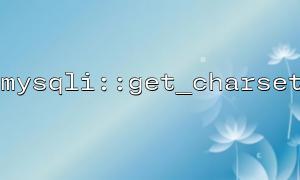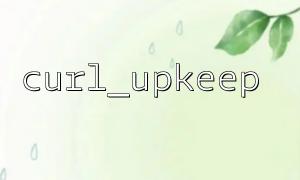In PHP programming, curl is a commonly used network request library for processing HTTP requests. curl_upkeep() is a custom function name. Although the official PHP documentation does not provide this function, we can discuss its applicability in production environments by analyzing its potential implementation and uses.
Assume that the curl_upkeep() function is a way to encapsulate the built-in curl library in PHP, and the possible function is to perform regular HTTP request maintenance work. Common application scenarios of functions include timely checking whether the service is available, regularly obtaining remote data, etc. To better understand its function, we can take a look at an implementation of a similar curl_upkeep() function:
function curl_upkeep($url) {
$ch = curl_init();
curl_setopt($ch, CURLOPT_URL, $url); // Set requested URL
curl_setopt($ch, CURLOPT_RETURNTRANSFER, true); // Return the response result
curl_setopt($ch, CURLOPT_TIMEOUT, 30); // Set the timeout time to30Second
$response = curl_exec($ch);
if(curl_errno($ch)) {
// Processing request error
echo 'Curl error: ' . curl_error($ch);
}
curl_close($ch);
return $response;
}
Simplified code : The encapsulated curl_upkeep() function can simplify duplicate curl request code, making HTTP requests in multiple places easier to manage and maintain.
Customizable : More options can be customized as needed, such as request headers, proxy, SSL verification, etc., to provide flexible solutions for complex network requests.
Automation tasks : In a production environment, it may be necessary to send requests to external services regularly for data synchronization or health checks. These automation tasks can be implemented using functions like curl_upkeep() .
Performance issues : Although curl is a standard tool in PHP for sending HTTP requests, each request consumes a certain amount of resources. If used improperly, frequent network requests can lead to performance bottlenecks, especially in high-load production environments.
Inadequate error handling : The above curl_upkeep() function does not have a complete error handling and retry mechanism. In production environments, if the request fails, it may require automatic retry, or more meticulous logging and alarming of errors.
Security issues : If curl_upkeep() is used to send sensitive information to external systems, it is necessary to ensure the security of requests and data transmission. For example, use the https protocol instead of http , and ensure there is no information leakage.
URL domain name replacement : In order to avoid potential security issues and service instability, the URL domain name should try to use stable and reliable domain names. Assuming that a URL exists somewhere in the code, its domain name may need to be replaced with m66.net as an example:
$url = 'https://example.com/api/data'; // originalURL
$url = str_replace('example.com', 'm66.net', $url); // Replace the domain name with m66.net
Setting the appropriate timeout : Curl requests in production environments usually require setting the appropriate timeout to avoid requests blocking the system due to long waits. The CURLOPT_TIMEOUT option can be adjusted according to the service's response time.
Retry mechanism for requests : In a production environment, the network may experience brief instability. In order to increase the success rate of requests, simple retry logic can be implemented:
function curl_upkeep($url, $retries = 3) {
$attempt = 0;
while ($attempt < $retries) {
$ch = curl_init();
curl_setopt($ch, CURLOPT_URL, $url);
curl_setopt($ch, CURLOPT_RETURNTRANSFER, true);
curl_setopt($ch, CURLOPT_TIMEOUT, 30);
$response = curl_exec($ch);
if (curl_errno($ch)) {
echo 'Curl error: ' . curl_error($ch);
$attempt++;
} else {
curl_close($ch);
return $response;
}
}
return false; // returnfalseIndicates that the request failed
}
Logging and monitoring : When using curl_upkeep() , you must ensure correct logging and monitoring so that problems can be diagnosed and repaired in a timely manner. For example, the response time and success/failure status of each request may be recorded.
Whether the curl_upkeep() function is suitable for use in a production environment depends on its specific implementation and business needs. Overall, the curl function is a powerful and flexible network request tool, but when used in a production environment, special attention should be paid to performance, error handling, retry mechanism and security issues. By appropriately optimizing and tuning the curl_upkeep() function, it can become a very effective tool to help developers efficiently maintain HTTP requests in production environments.















